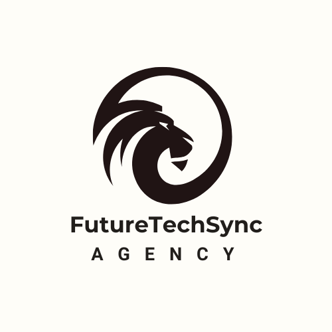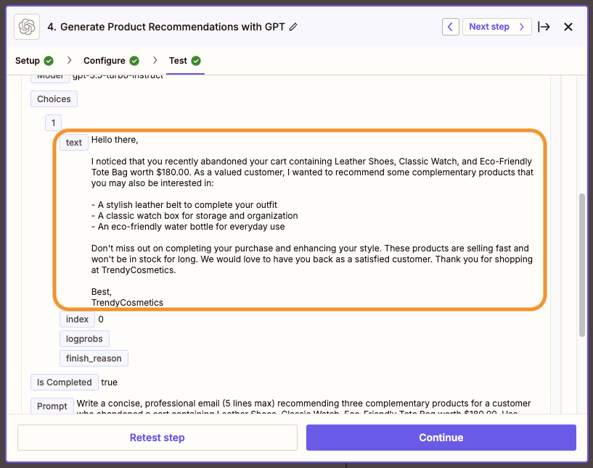Personalized Cart Reminders That Boosted TrendyCosmetics' Conversion Rates


Every month, TrendyCosmetics was losing over $18,000 to abandoned carts.
Like many growing beauty brands, they faced the same problem—customers adding products to their carts but leaving before checkout. Their team spent 5+ hours a day manually following up, yet conversions remained low.
They needed a way to recover lost sales without adding more workload. By automating their cart reminders, they streamlined follow-ups, improved engagement, and saw their recovery rate increase 5X—all while reducing manual effort.
Here’s how they did it.
Manual Follow-Ups and Missed Opportunities:


Before automation, TrendyCosmetics relied on slow, manual follow-ups that rarely converted customers.
Delayed Emails → By the time emails were sent, customers had already moved on.
One-Size-Fits-All Messaging → Generic emails failed to re-engage buyers.
No Clear Prioritization → No way to identify high-value customers most likely to complete their purchase.
The team was losing time and sales, stuck in a system that couldn’t scale. They needed a smarter approach.
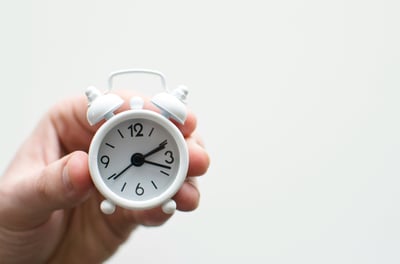



Time and Cost of Manual Management:
TrendyCosmetics was spending over $4,000/month on manual follow-ups—yet conversion rates remained stuck below 5%.
5+ hours per day wasted chasing lost sales.
High costs, low return → A full-time salary spent on emails that rarely converted.
A system that didn’t scale → More abandoned carts meant more work, not more revenue.
This wasn’t just inefficient—it was a losing game. They needed a way to recover sales without increasing workload.
TrendyCosmetics was losing 30% of potential sales simply because there was no system in place to recover abandoned carts.
$6,000 in wasted ad spend → Paid ads brought visitors, but without follow-ups, many never converted.
Missed revenue opportunities → A structured recovery strategy could have turned lost carts into a steady revenue stream.
Low customer retention → Buyers who showed interest received no incentives to return, reducing repeat sales.
Every abandoned cart wasn’t just a lost sale—it was a missed chance to grow the business.
Impact of Cart Abandonment:
The Challenge: High Cart Abandonment Rates
Every day, TrendyCosmetics recorded approximately 120 abandoned carts, with no structured system for following up:
The True Cost of Inefficient Cart Recovery
Operational Strain: Manual processes consumed significant time and resources, limiting the team’s ability to focus on growth initiatives.
Lost Revenue Potential: Ineffective recovery strategies meant a consistent loss of potential sales and revenue.
Customer Retention Challenges: Inadequate follow-ups impacted customer satisfaction, reducing repeat purchases and lifetime value.
Limited Scalability: The high workload from manual tasks created barriers to scaling operations efficiently.
The Key Question:
How much revenue is your business losing every month to abandoned carts?
What if you could recover those lost sales automatically—without increasing your workload?
Proposed Solution: Automated, Personalized Cart Reminders
To stop losing sales, TrendyCosmetics automated their entire abandoned cart recovery process—turning lost revenue into growth without adding manual work.
Here’s what changed:
Smart Follow-Ups at the Right Time → Automated emails & SMS reached customers when they were most likely to buy.
Personalized Messaging That Converts → Instead of generic reminders, AI-generated messages matched each customer's behavior.
Targeting High-Value Customers First → Prioritized shoppers who were most likely to complete their purchase.
Scalable & Hands-Free → Whether 10 or 1,000 carts were abandoned, the system worked 24/7—no extra effort required.
By replacing manual work with smart automation, TrendyCosmetics recovered 5X more sales while reducing their team’s workload.
Step 1: Trigger Activation
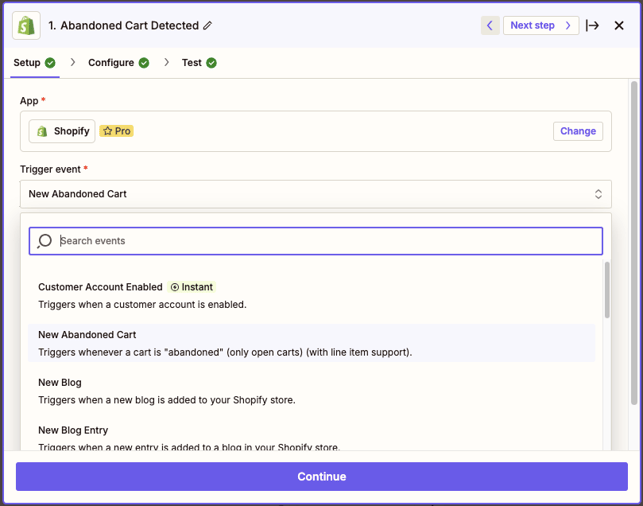

Screenshot: Zapier interface showing the setup of the "New Abandoned Cart." trigger.
Trigger: "Abandoned Cart Detected"
Where to Configure: In Zapier, create a new Zap and select Shopify as the app.
What to Set Up: Choose the event “New Abandoned Cart”
How to Test: Ensure Zapier captures sample data, such as customer email and cart details.
Expected Outcome: Automation is initiated as soon as a cart is abandoned.
Pro Tip: Focus on high-value carts (e.g., over $50) to maximize recovery impact while optimizing time and resources.
Troubleshooting Tips: Ensure Shopify's webhook settings are correct and integration authentication is up-to-date to capture cart abandonment data reliably.
Side Note: Add a 2-3 hour delay before follow-ups to let customers complete their purchases naturally, avoiding unnecessary reminders.
Step-by-Step Implementation
Step 2: AI Content Generation (SMS)
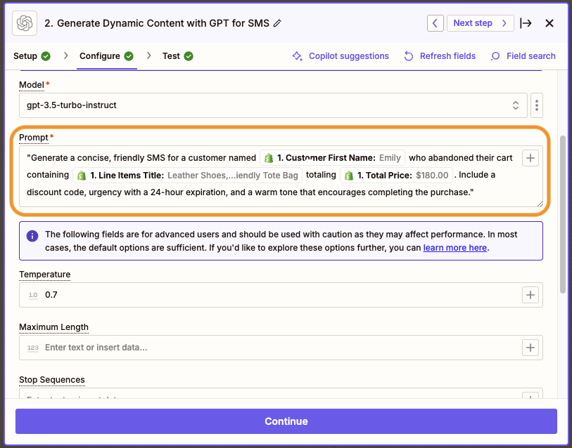

Action: Generate Dynamic Content with GPT
Where to Configure:
Use GPT through an API call or integration in Zapier.
What to Do:
Create personalized SMS content, email messages, and product recommendations.
Ensure GPT is configured to output concise, engaging, and relevant text for each communication channel.
How to Test:
Generate sample outputs to verify accuracy and relevance of the content.
Expected Outcome: AI-generated content tailored to individual customer data, ready for use in subsequent workflow steps.
Pro Tip:
Predefine prompts tailored to each channel to maintain consistency and effectiveness in messaging.
Troubleshooting Tips:
Review prompts and input data if outputs are inconsistent or irrelevant.
Monitor API usage to ensure calls are within quota limits.
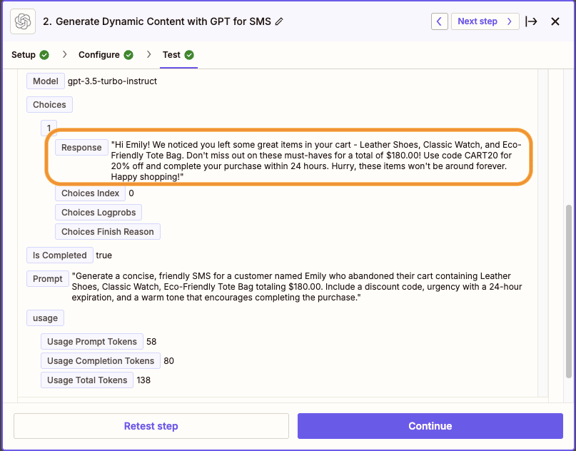

Step 3: AI-Powered SMS Follow-Up
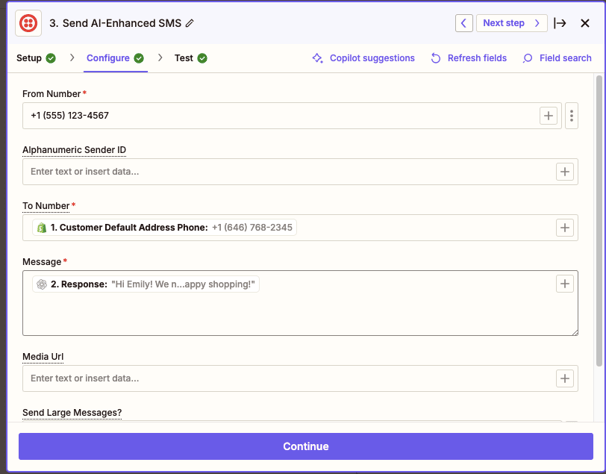

Action: Send Prompt to OpenAI
Where to Configure: Use Twilio in Zapier.
What to Do:
Add a delay of 2-3 hours after the email reminder to avoid overwhelming the customer.
Use dynamic SMS content generated in the preceding AI step.
Include urgency (e.g., "Your favorite items are still waiting! Enjoy 10% off if you complete your purchase in the next 6 hours.").
How to Test:
Verify SMS formatting and delivery with sample data.
Expected Outcome: Highly engaging, context-aware messages that resonate with customers.
Pro Tip: Limit AI-generated SMS to frequent shoppers or high-value carts for maximum ROI.
Troubleshooting Tips:
Confirm Twilio's phone number settings and test SMS delivery in different regions.
If SMS is not delivered, ensure the Twilio sender ID is verified and matches the customer's location.
Side Note: A delay here ensures SMS communication doesn’t follow too closely after the email, giving the customer time to act before receiving another nudge.
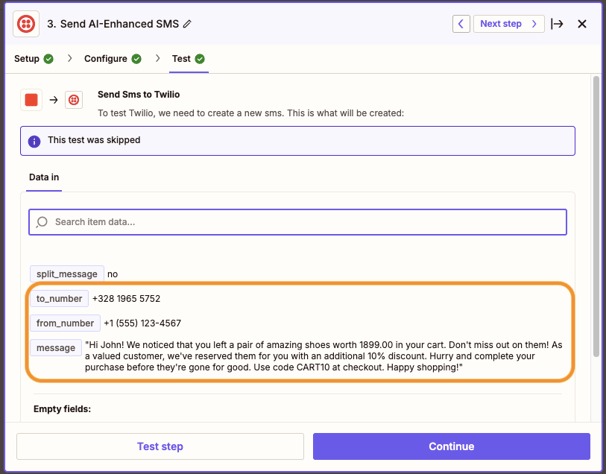

Step 4: AI Content Generation for Recommendations
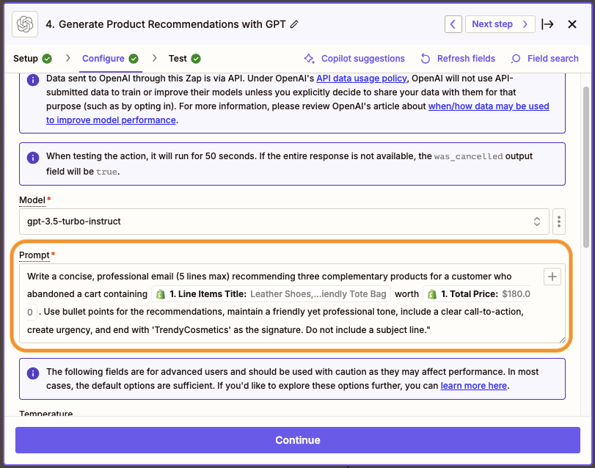

Where to Configure: Use OpenAI in Zapier.
What to Do:
Map the cart items dynamically from the Shopify trigger.
Set parameters like temperature (e.g., 0.7 for balanced creativity)
How to Test:
Run a test to ensure GPT generates accurate and relevant product recommendations based on the provided cart items.
Expected Outcome:
A list of three complementary product suggestions tailored to the cart contents.
Pro Tip:
Refine the prompt to include product categories or themes for more accurate recommendations.
Troubleshooting Tips:
If recommendations seem irrelevant, adjust the prompt to provide more specific context (e.g., product type or cart value).
Verify the input fields are correctly mapped and contain valid data.
Step 5: Email for Product Recommendations
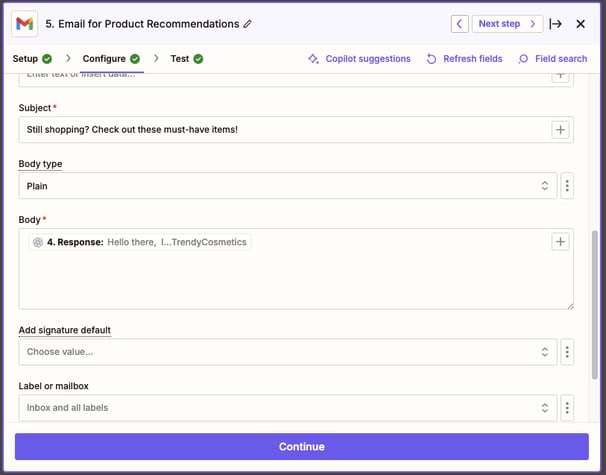

Action: Send AI-Generated Recommendations via Email
Where to Configure: Use Gmail in Zapier.
What to Do:
Set up an email action step in Zapier.
Use the recommendations generated in Step 4 to personalize the email body.
How to Test:
Send a test email to ensure recommendations are correctly inserted and formatting is consistent.
Expected Outcome:
A highly personalized email that re-engages the customer and boosts upsell opportunities.
Pro Tip:
Include a direct link to the customer’s abandoned cart for convenience.
Troubleshooting Tips:
Check email formatting for mobile responsiveness.
Ensure dynamic fields are mapped correctly.
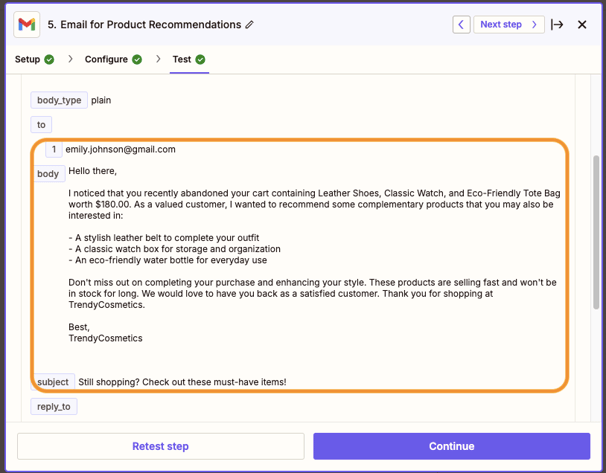

Step 6: Analytics and Segmentation
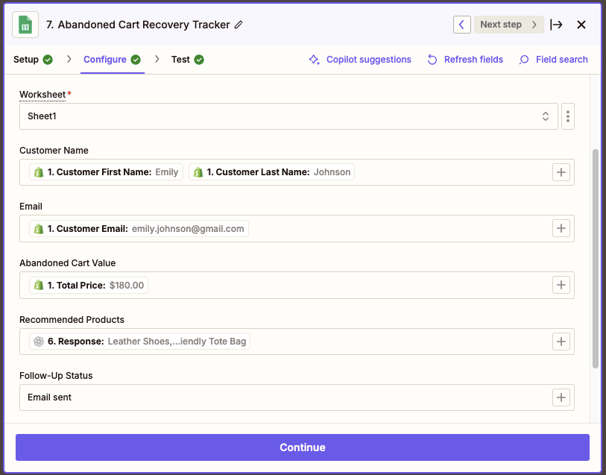

Action: Update CRM with Cart Data
Where to Configure: Add a Google Sheets action in Zapier.
What to Do: Log details of abandoned carts, follow-up actions, and conversions.
How to Test: Ensure data is updated accurately in real time.
Expected Outcome: A centralized database for tracking cart recovery performance.
Pro Tip: Use this data to refine segmentation strategies for future campaigns.
Troubleshooting Tips:
Check Google Sheets' column headers for consistency with mapped fields.
If data is not updating, ensure the sheet is shared with the appropriate permissions for Zapier.
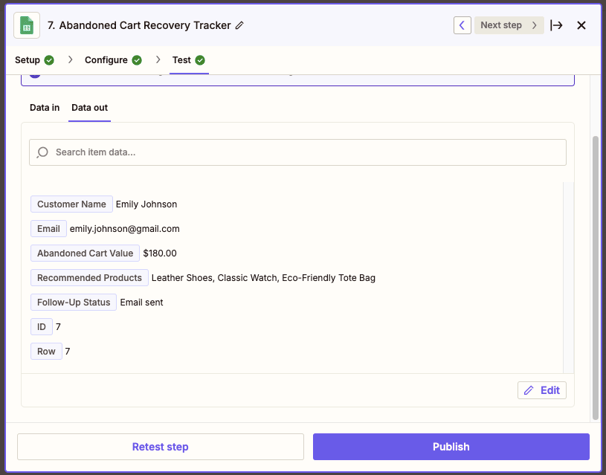

Key Benefits of Automation
What Automation Delivered for TrendyCosmetics
$18,000/month recovered → Cart recovery rate increased from 5% to 25% in just one month.
5X more conversions → More abandoned carts turned into completed purchases—without extra effort.
Lower costs, higher ROI → Less reliance on paid ads while increasing overall sales.
Better customer engagement → Email open rates grew by 45%, and SMS click-through rates exceeded 30%.
Freed up 5+ hours per day → The team stopped chasing lost sales and focused on growth instead.
By switching to smart automation, TrendyCosmetics transformed abandoned carts from a costly problem into a consistent revenue stream.
Recover More Sales—Without Extra Work
TrendyCosmetics recovered $18,000/month with automation. How much are you leaving on the table?
Let’s find out. Get a free audit today and see how much you could recover—starting this week.


